Youth Smoking: Alarming Issue and Health Promotion Strategies
VerifiedAdded on 2023/04/05
|13
|2049
|467
AI Summary
This report provides insights into the alarming issue of youth smoking and offers recommendations for effective health promotion strategies. It discusses the factors influencing youth smoking and the need for intervention. The report also highlights different methods for health promotion and provides recommendations to address this health issue.
Contribute Materials
Your contribution can guide someone’s learning journey. Share your
documents today.
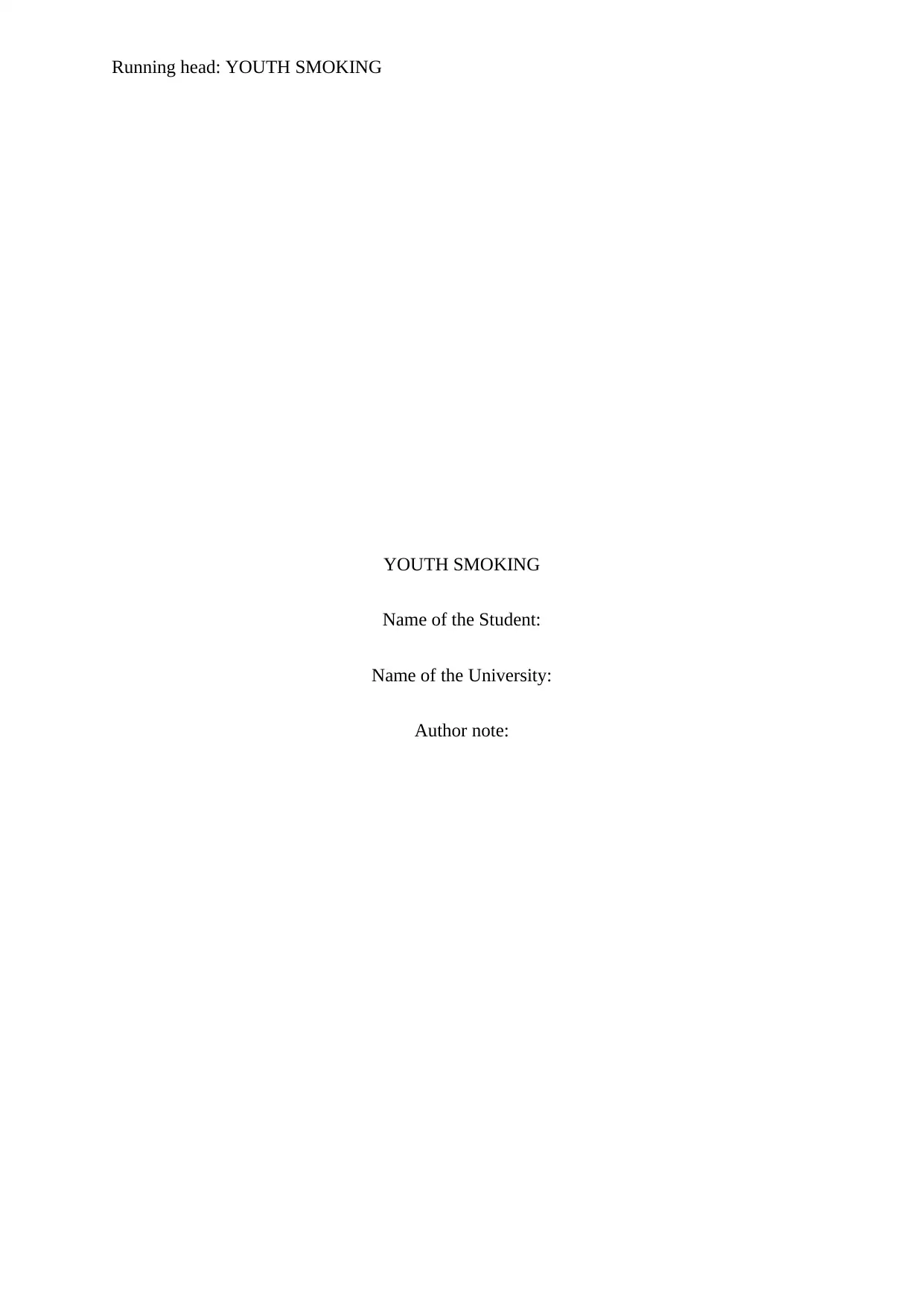
Running head: YOUTH SMOKING
YOUTH SMOKING
Name of the Student:
Name of the University:
Author note:
YOUTH SMOKING
Name of the Student:
Name of the University:
Author note:
Secure Best Marks with AI Grader
Need help grading? Try our AI Grader for instant feedback on your assignments.
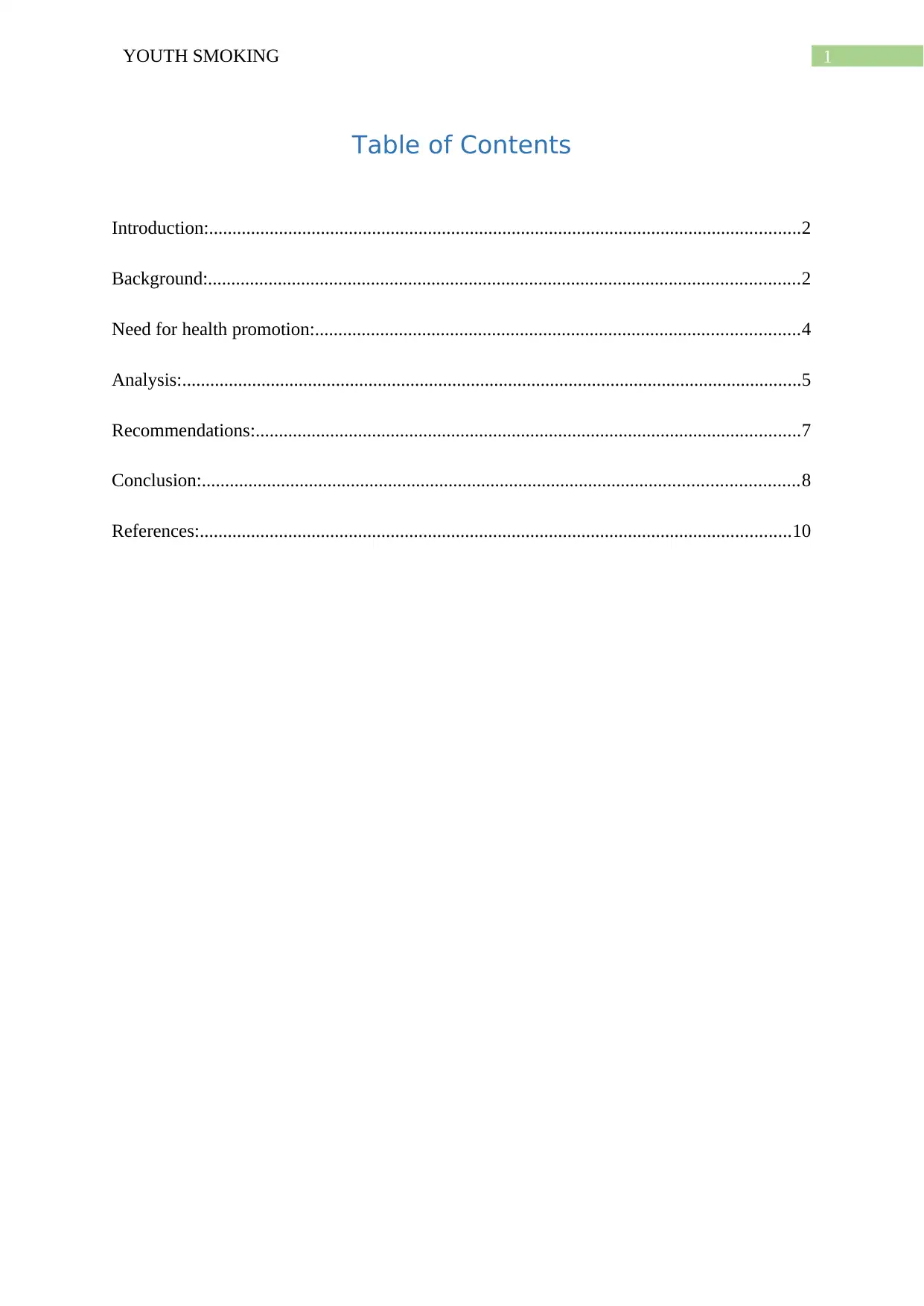
1YOUTH SMOKING
Table of Contents
Introduction:...............................................................................................................................2
Background:...............................................................................................................................2
Need for health promotion:........................................................................................................4
Analysis:.....................................................................................................................................5
Recommendations:.....................................................................................................................7
Conclusion:................................................................................................................................8
References:...............................................................................................................................10
Table of Contents
Introduction:...............................................................................................................................2
Background:...............................................................................................................................2
Need for health promotion:........................................................................................................4
Analysis:.....................................................................................................................................5
Recommendations:.....................................................................................................................7
Conclusion:................................................................................................................................8
References:...............................................................................................................................10
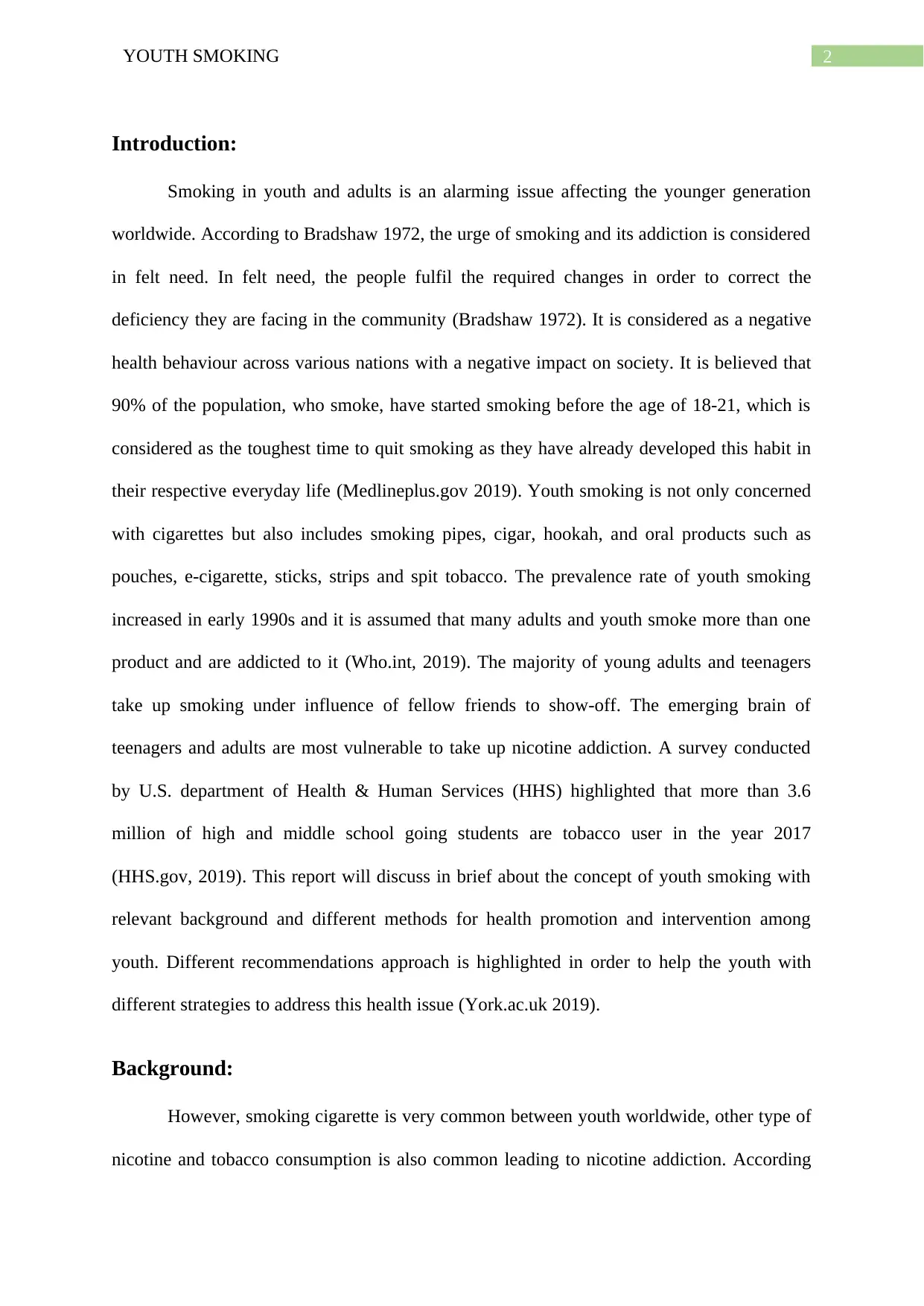
2YOUTH SMOKING
Introduction:
Smoking in youth and adults is an alarming issue affecting the younger generation
worldwide. According to Bradshaw 1972, the urge of smoking and its addiction is considered
in felt need. In felt need, the people fulfil the required changes in order to correct the
deficiency they are facing in the community (Bradshaw 1972). It is considered as a negative
health behaviour across various nations with a negative impact on society. It is believed that
90% of the population, who smoke, have started smoking before the age of 18-21, which is
considered as the toughest time to quit smoking as they have already developed this habit in
their respective everyday life (Medlineplus.gov 2019). Youth smoking is not only concerned
with cigarettes but also includes smoking pipes, cigar, hookah, and oral products such as
pouches, e-cigarette, sticks, strips and spit tobacco. The prevalence rate of youth smoking
increased in early 1990s and it is assumed that many adults and youth smoke more than one
product and are addicted to it (Who.int, 2019). The majority of young adults and teenagers
take up smoking under influence of fellow friends to show-off. The emerging brain of
teenagers and adults are most vulnerable to take up nicotine addiction. A survey conducted
by U.S. department of Health & Human Services (HHS) highlighted that more than 3.6
million of high and middle school going students are tobacco user in the year 2017
(HHS.gov, 2019). This report will discuss in brief about the concept of youth smoking with
relevant background and different methods for health promotion and intervention among
youth. Different recommendations approach is highlighted in order to help the youth with
different strategies to address this health issue (York.ac.uk 2019).
Background:
However, smoking cigarette is very common between youth worldwide, other type of
nicotine and tobacco consumption is also common leading to nicotine addiction. According
Introduction:
Smoking in youth and adults is an alarming issue affecting the younger generation
worldwide. According to Bradshaw 1972, the urge of smoking and its addiction is considered
in felt need. In felt need, the people fulfil the required changes in order to correct the
deficiency they are facing in the community (Bradshaw 1972). It is considered as a negative
health behaviour across various nations with a negative impact on society. It is believed that
90% of the population, who smoke, have started smoking before the age of 18-21, which is
considered as the toughest time to quit smoking as they have already developed this habit in
their respective everyday life (Medlineplus.gov 2019). Youth smoking is not only concerned
with cigarettes but also includes smoking pipes, cigar, hookah, and oral products such as
pouches, e-cigarette, sticks, strips and spit tobacco. The prevalence rate of youth smoking
increased in early 1990s and it is assumed that many adults and youth smoke more than one
product and are addicted to it (Who.int, 2019). The majority of young adults and teenagers
take up smoking under influence of fellow friends to show-off. The emerging brain of
teenagers and adults are most vulnerable to take up nicotine addiction. A survey conducted
by U.S. department of Health & Human Services (HHS) highlighted that more than 3.6
million of high and middle school going students are tobacco user in the year 2017
(HHS.gov, 2019). This report will discuss in brief about the concept of youth smoking with
relevant background and different methods for health promotion and intervention among
youth. Different recommendations approach is highlighted in order to help the youth with
different strategies to address this health issue (York.ac.uk 2019).
Background:
However, smoking cigarette is very common between youth worldwide, other type of
nicotine and tobacco consumption is also common leading to nicotine addiction. According
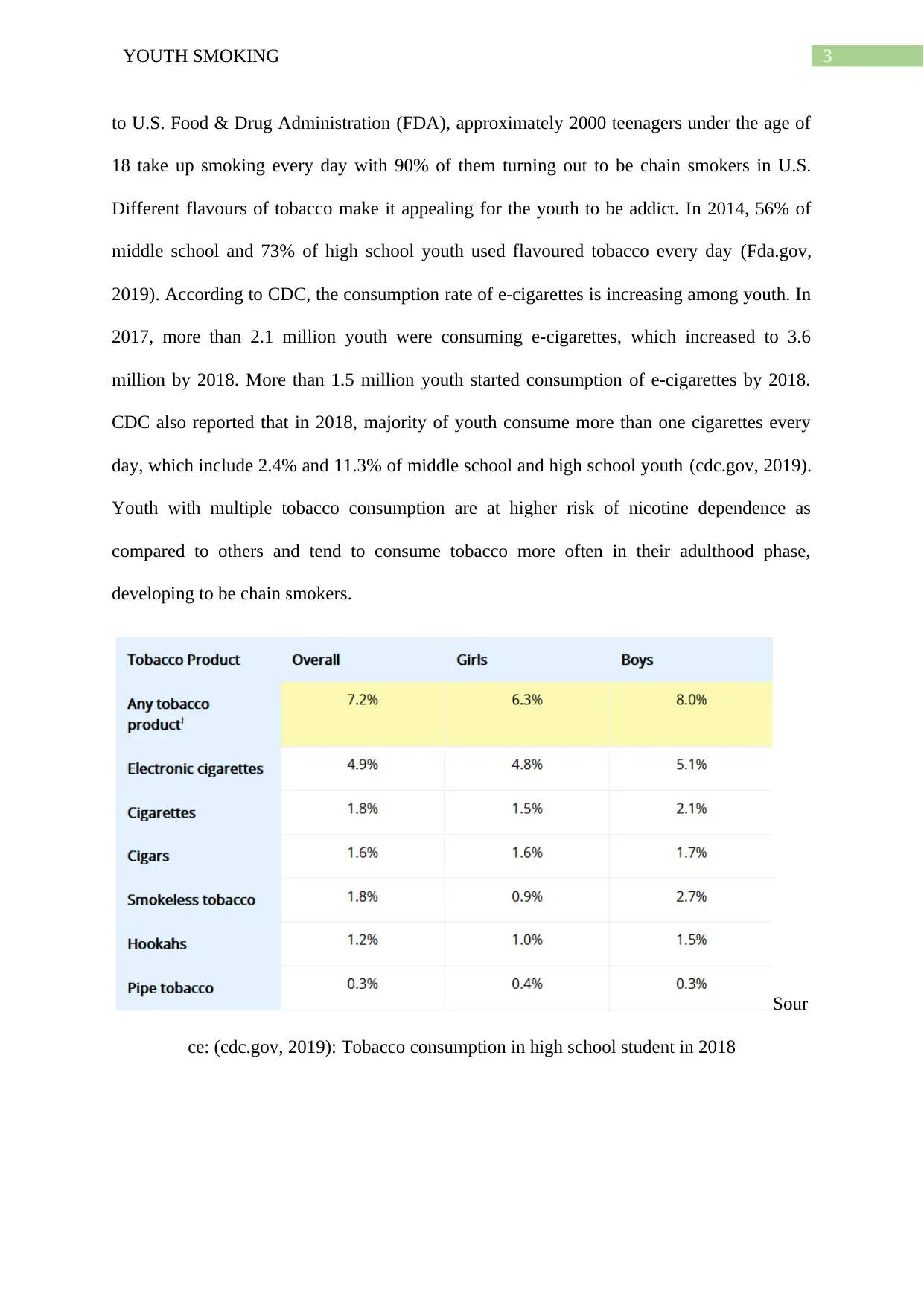
3YOUTH SMOKING
to U.S. Food & Drug Administration (FDA), approximately 2000 teenagers under the age of
18 take up smoking every day with 90% of them turning out to be chain smokers in U.S.
Different flavours of tobacco make it appealing for the youth to be addict. In 2014, 56% of
middle school and 73% of high school youth used flavoured tobacco every day (Fda.gov,
2019). According to CDC, the consumption rate of e-cigarettes is increasing among youth. In
2017, more than 2.1 million youth were consuming e-cigarettes, which increased to 3.6
million by 2018. More than 1.5 million youth started consumption of e-cigarettes by 2018.
CDC also reported that in 2018, majority of youth consume more than one cigarettes every
day, which include 2.4% and 11.3% of middle school and high school youth (cdc.gov, 2019).
Youth with multiple tobacco consumption are at higher risk of nicotine dependence as
compared to others and tend to consume tobacco more often in their adulthood phase,
developing to be chain smokers.
Sour
ce: (cdc.gov, 2019): Tobacco consumption in high school student in 2018
to U.S. Food & Drug Administration (FDA), approximately 2000 teenagers under the age of
18 take up smoking every day with 90% of them turning out to be chain smokers in U.S.
Different flavours of tobacco make it appealing for the youth to be addict. In 2014, 56% of
middle school and 73% of high school youth used flavoured tobacco every day (Fda.gov,
2019). According to CDC, the consumption rate of e-cigarettes is increasing among youth. In
2017, more than 2.1 million youth were consuming e-cigarettes, which increased to 3.6
million by 2018. More than 1.5 million youth started consumption of e-cigarettes by 2018.
CDC also reported that in 2018, majority of youth consume more than one cigarettes every
day, which include 2.4% and 11.3% of middle school and high school youth (cdc.gov, 2019).
Youth with multiple tobacco consumption are at higher risk of nicotine dependence as
compared to others and tend to consume tobacco more often in their adulthood phase,
developing to be chain smokers.
Sour
ce: (cdc.gov, 2019): Tobacco consumption in high school student in 2018
Secure Best Marks with AI Grader
Need help grading? Try our AI Grader for instant feedback on your assignments.
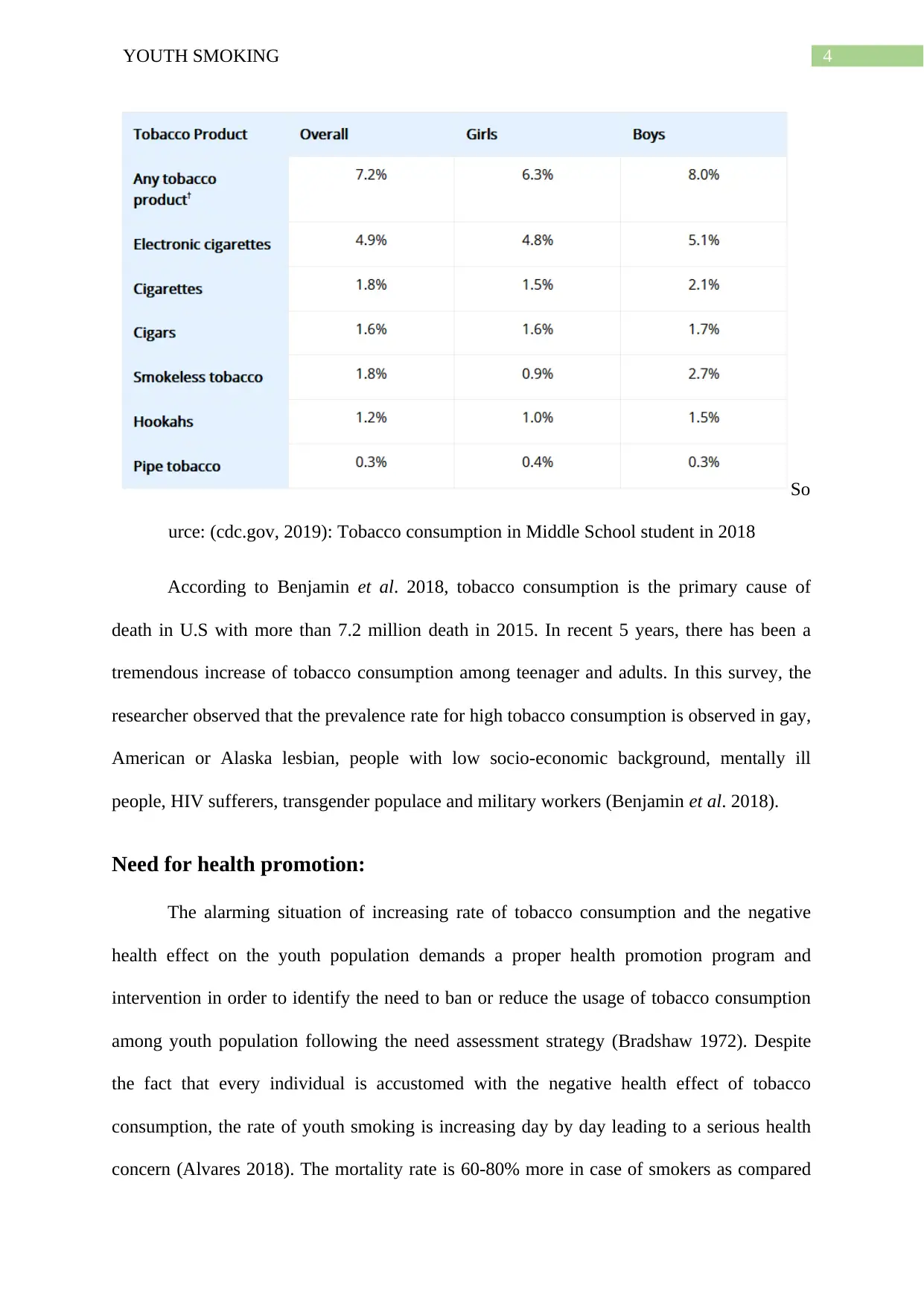
4YOUTH SMOKING
So
urce: (cdc.gov, 2019): Tobacco consumption in Middle School student in 2018
According to Benjamin et al. 2018, tobacco consumption is the primary cause of
death in U.S with more than 7.2 million death in 2015. In recent 5 years, there has been a
tremendous increase of tobacco consumption among teenager and adults. In this survey, the
researcher observed that the prevalence rate for high tobacco consumption is observed in gay,
American or Alaska lesbian, people with low socio-economic background, mentally ill
people, HIV sufferers, transgender populace and military workers (Benjamin et al. 2018).
Need for health promotion:
The alarming situation of increasing rate of tobacco consumption and the negative
health effect on the youth population demands a proper health promotion program and
intervention in order to identify the need to ban or reduce the usage of tobacco consumption
among youth population following the need assessment strategy (Bradshaw 1972). Despite
the fact that every individual is accustomed with the negative health effect of tobacco
consumption, the rate of youth smoking is increasing day by day leading to a serious health
concern (Alvares 2018). The mortality rate is 60-80% more in case of smokers as compared
So
urce: (cdc.gov, 2019): Tobacco consumption in Middle School student in 2018
According to Benjamin et al. 2018, tobacco consumption is the primary cause of
death in U.S with more than 7.2 million death in 2015. In recent 5 years, there has been a
tremendous increase of tobacco consumption among teenager and adults. In this survey, the
researcher observed that the prevalence rate for high tobacco consumption is observed in gay,
American or Alaska lesbian, people with low socio-economic background, mentally ill
people, HIV sufferers, transgender populace and military workers (Benjamin et al. 2018).
Need for health promotion:
The alarming situation of increasing rate of tobacco consumption and the negative
health effect on the youth population demands a proper health promotion program and
intervention in order to identify the need to ban or reduce the usage of tobacco consumption
among youth population following the need assessment strategy (Bradshaw 1972). Despite
the fact that every individual is accustomed with the negative health effect of tobacco
consumption, the rate of youth smoking is increasing day by day leading to a serious health
concern (Alvares 2018). The mortality rate is 60-80% more in case of smokers as compared
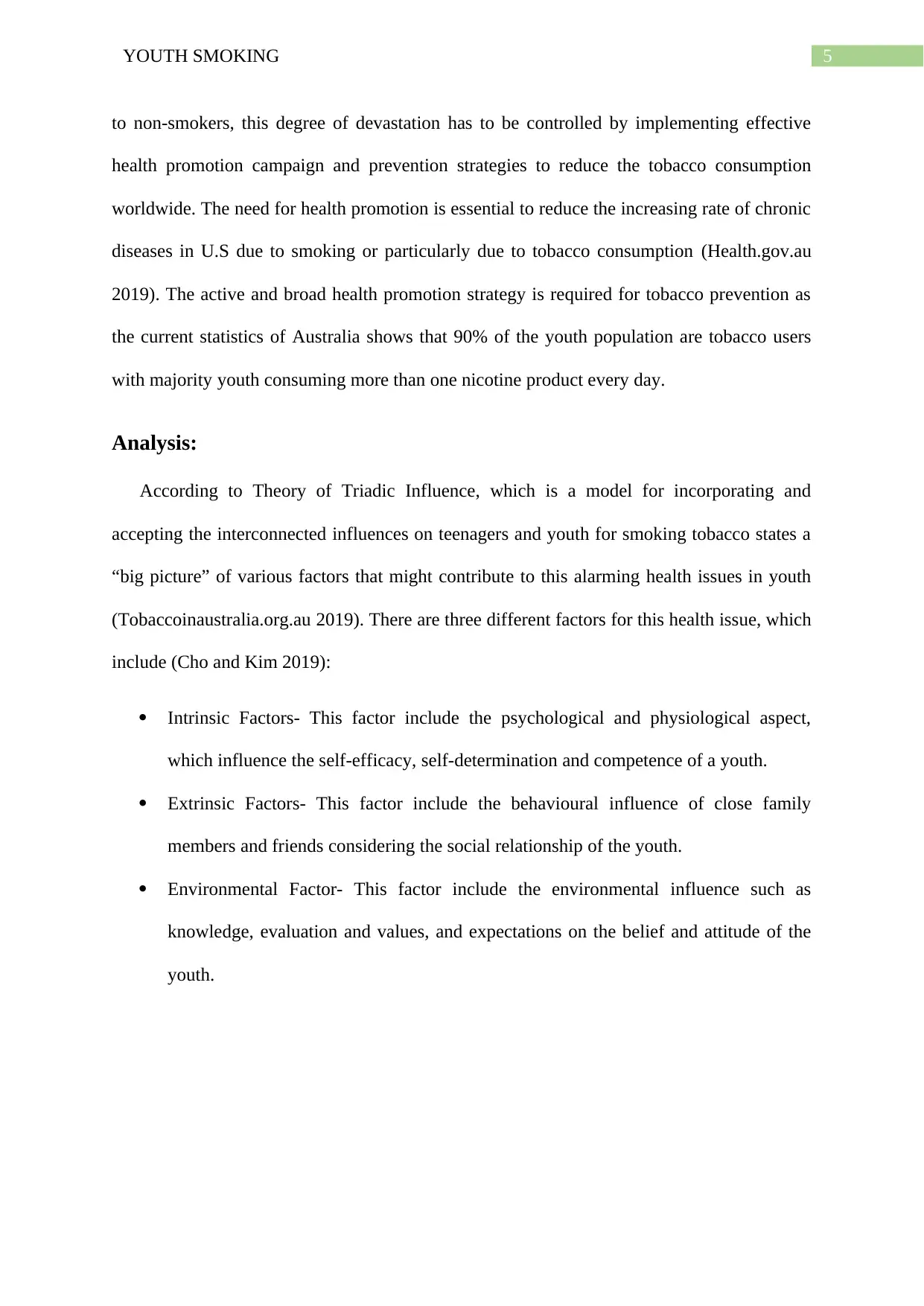
5YOUTH SMOKING
to non-smokers, this degree of devastation has to be controlled by implementing effective
health promotion campaign and prevention strategies to reduce the tobacco consumption
worldwide. The need for health promotion is essential to reduce the increasing rate of chronic
diseases in U.S due to smoking or particularly due to tobacco consumption (Health.gov.au
2019). The active and broad health promotion strategy is required for tobacco prevention as
the current statistics of Australia shows that 90% of the youth population are tobacco users
with majority youth consuming more than one nicotine product every day.
Analysis:
According to Theory of Triadic Influence, which is a model for incorporating and
accepting the interconnected influences on teenagers and youth for smoking tobacco states a
“big picture” of various factors that might contribute to this alarming health issues in youth
(Tobaccoinaustralia.org.au 2019). There are three different factors for this health issue, which
include (Cho and Kim 2019):
Intrinsic Factors- This factor include the psychological and physiological aspect,
which influence the self-efficacy, self-determination and competence of a youth.
Extrinsic Factors- This factor include the behavioural influence of close family
members and friends considering the social relationship of the youth.
Environmental Factor- This factor include the environmental influence such as
knowledge, evaluation and values, and expectations on the belief and attitude of the
youth.
to non-smokers, this degree of devastation has to be controlled by implementing effective
health promotion campaign and prevention strategies to reduce the tobacco consumption
worldwide. The need for health promotion is essential to reduce the increasing rate of chronic
diseases in U.S due to smoking or particularly due to tobacco consumption (Health.gov.au
2019). The active and broad health promotion strategy is required for tobacco prevention as
the current statistics of Australia shows that 90% of the youth population are tobacco users
with majority youth consuming more than one nicotine product every day.
Analysis:
According to Theory of Triadic Influence, which is a model for incorporating and
accepting the interconnected influences on teenagers and youth for smoking tobacco states a
“big picture” of various factors that might contribute to this alarming health issues in youth
(Tobaccoinaustralia.org.au 2019). There are three different factors for this health issue, which
include (Cho and Kim 2019):
Intrinsic Factors- This factor include the psychological and physiological aspect,
which influence the self-efficacy, self-determination and competence of a youth.
Extrinsic Factors- This factor include the behavioural influence of close family
members and friends considering the social relationship of the youth.
Environmental Factor- This factor include the environmental influence such as
knowledge, evaluation and values, and expectations on the belief and attitude of the
youth.
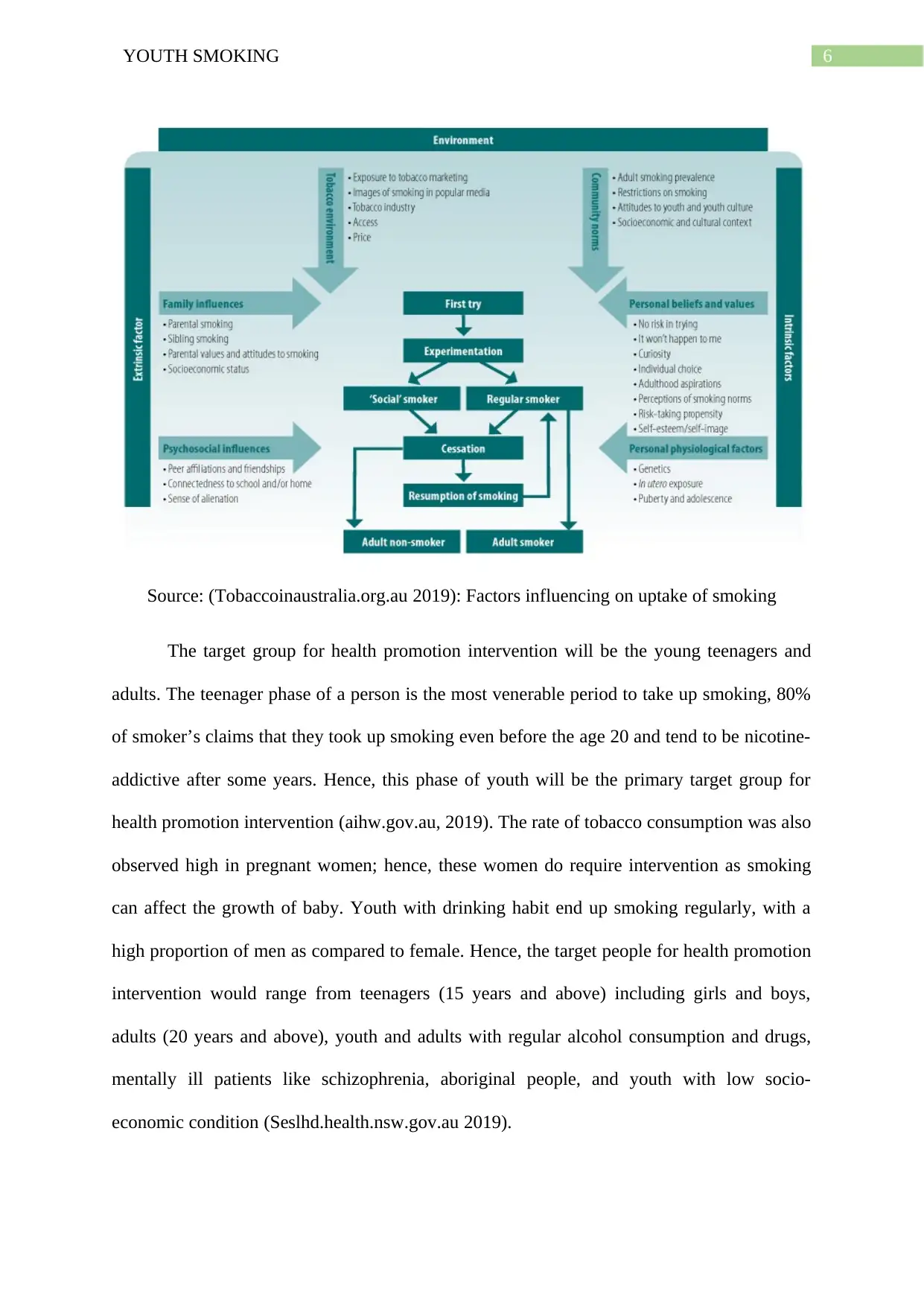
6YOUTH SMOKING
Source: (Tobaccoinaustralia.org.au 2019): Factors influencing on uptake of smoking
The target group for health promotion intervention will be the young teenagers and
adults. The teenager phase of a person is the most venerable period to take up smoking, 80%
of smoker’s claims that they took up smoking even before the age 20 and tend to be nicotine-
addictive after some years. Hence, this phase of youth will be the primary target group for
health promotion intervention (aihw.gov.au, 2019). The rate of tobacco consumption was also
observed high in pregnant women; hence, these women do require intervention as smoking
can affect the growth of baby. Youth with drinking habit end up smoking regularly, with a
high proportion of men as compared to female. Hence, the target people for health promotion
intervention would range from teenagers (15 years and above) including girls and boys,
adults (20 years and above), youth and adults with regular alcohol consumption and drugs,
mentally ill patients like schizophrenia, aboriginal people, and youth with low socio-
economic condition (Seslhd.health.nsw.gov.au 2019).
Source: (Tobaccoinaustralia.org.au 2019): Factors influencing on uptake of smoking
The target group for health promotion intervention will be the young teenagers and
adults. The teenager phase of a person is the most venerable period to take up smoking, 80%
of smoker’s claims that they took up smoking even before the age 20 and tend to be nicotine-
addictive after some years. Hence, this phase of youth will be the primary target group for
health promotion intervention (aihw.gov.au, 2019). The rate of tobacco consumption was also
observed high in pregnant women; hence, these women do require intervention as smoking
can affect the growth of baby. Youth with drinking habit end up smoking regularly, with a
high proportion of men as compared to female. Hence, the target people for health promotion
intervention would range from teenagers (15 years and above) including girls and boys,
adults (20 years and above), youth and adults with regular alcohol consumption and drugs,
mentally ill patients like schizophrenia, aboriginal people, and youth with low socio-
economic condition (Seslhd.health.nsw.gov.au 2019).
Paraphrase This Document
Need a fresh take? Get an instant paraphrase of this document with our AI Paraphraser
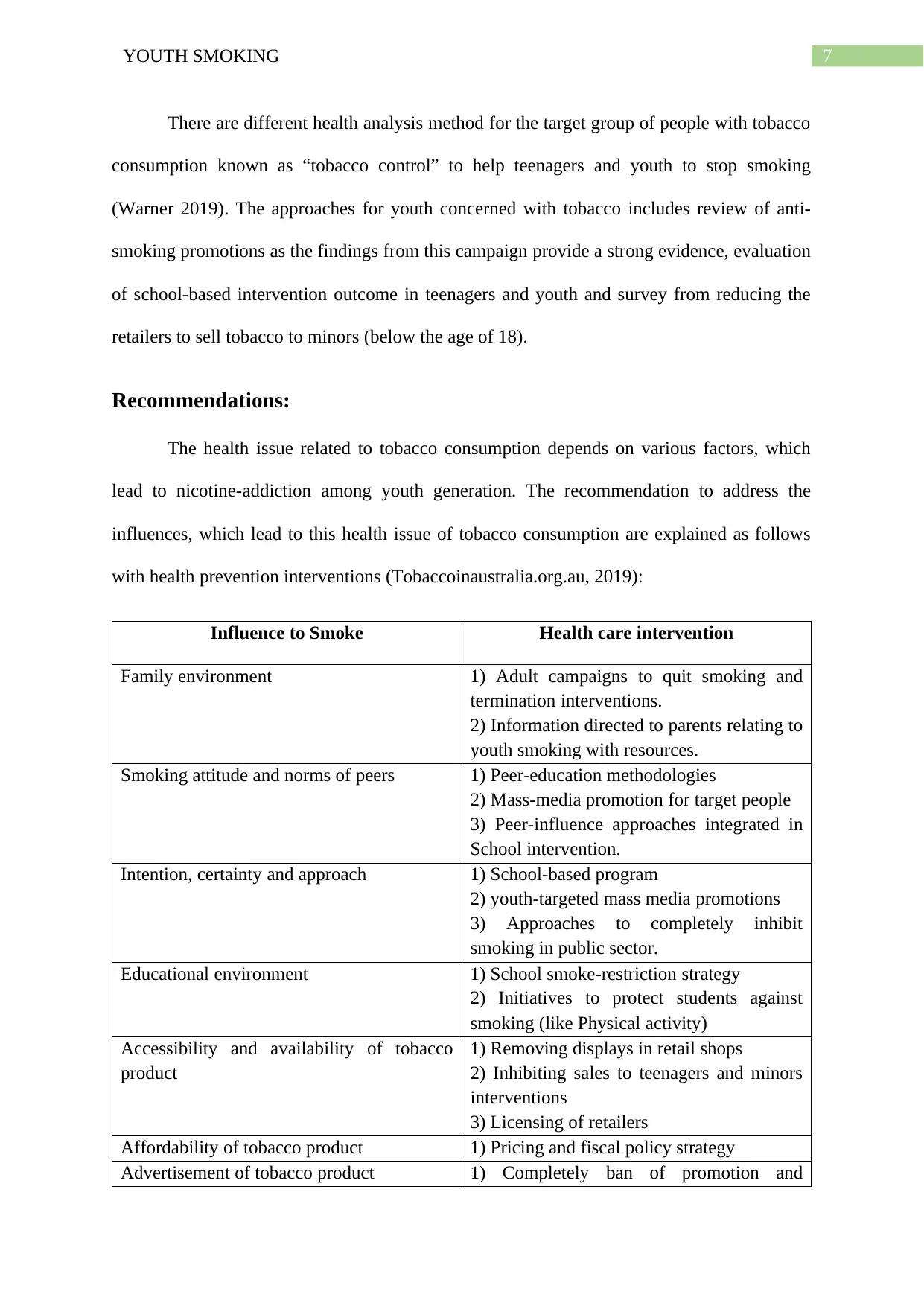
7YOUTH SMOKING
There are different health analysis method for the target group of people with tobacco
consumption known as “tobacco control” to help teenagers and youth to stop smoking
(Warner 2019). The approaches for youth concerned with tobacco includes review of anti-
smoking promotions as the findings from this campaign provide a strong evidence, evaluation
of school-based intervention outcome in teenagers and youth and survey from reducing the
retailers to sell tobacco to minors (below the age of 18).
Recommendations:
The health issue related to tobacco consumption depends on various factors, which
lead to nicotine-addiction among youth generation. The recommendation to address the
influences, which lead to this health issue of tobacco consumption are explained as follows
with health prevention interventions (Tobaccoinaustralia.org.au, 2019):
Influence to Smoke Health care intervention
Family environment 1) Adult campaigns to quit smoking and
termination interventions.
2) Information directed to parents relating to
youth smoking with resources.
Smoking attitude and norms of peers 1) Peer-education methodologies
2) Mass-media promotion for target people
3) Peer-influence approaches integrated in
School intervention.
Intention, certainty and approach 1) School-based program
2) youth-targeted mass media promotions
3) Approaches to completely inhibit
smoking in public sector.
Educational environment 1) School smoke-restriction strategy
2) Initiatives to protect students against
smoking (like Physical activity)
Accessibility and availability of tobacco
product
1) Removing displays in retail shops
2) Inhibiting sales to teenagers and minors
interventions
3) Licensing of retailers
Affordability of tobacco product 1) Pricing and fiscal policy strategy
Advertisement of tobacco product 1) Completely ban of promotion and
There are different health analysis method for the target group of people with tobacco
consumption known as “tobacco control” to help teenagers and youth to stop smoking
(Warner 2019). The approaches for youth concerned with tobacco includes review of anti-
smoking promotions as the findings from this campaign provide a strong evidence, evaluation
of school-based intervention outcome in teenagers and youth and survey from reducing the
retailers to sell tobacco to minors (below the age of 18).
Recommendations:
The health issue related to tobacco consumption depends on various factors, which
lead to nicotine-addiction among youth generation. The recommendation to address the
influences, which lead to this health issue of tobacco consumption are explained as follows
with health prevention interventions (Tobaccoinaustralia.org.au, 2019):
Influence to Smoke Health care intervention
Family environment 1) Adult campaigns to quit smoking and
termination interventions.
2) Information directed to parents relating to
youth smoking with resources.
Smoking attitude and norms of peers 1) Peer-education methodologies
2) Mass-media promotion for target people
3) Peer-influence approaches integrated in
School intervention.
Intention, certainty and approach 1) School-based program
2) youth-targeted mass media promotions
3) Approaches to completely inhibit
smoking in public sector.
Educational environment 1) School smoke-restriction strategy
2) Initiatives to protect students against
smoking (like Physical activity)
Accessibility and availability of tobacco
product
1) Removing displays in retail shops
2) Inhibiting sales to teenagers and minors
interventions
3) Licensing of retailers
Affordability of tobacco product 1) Pricing and fiscal policy strategy
Advertisement of tobacco product 1) Completely ban of promotion and
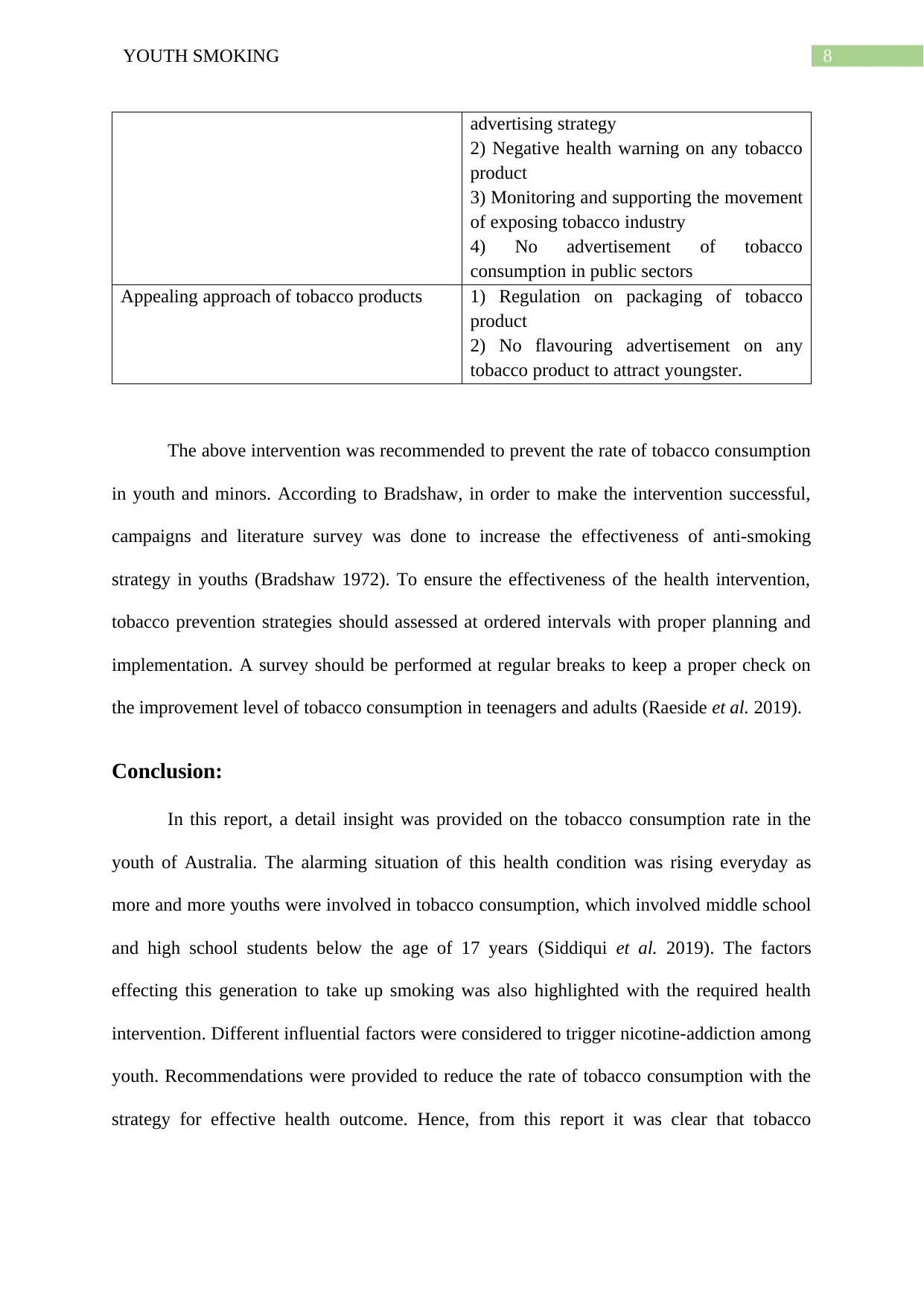
8YOUTH SMOKING
advertising strategy
2) Negative health warning on any tobacco
product
3) Monitoring and supporting the movement
of exposing tobacco industry
4) No advertisement of tobacco
consumption in public sectors
Appealing approach of tobacco products 1) Regulation on packaging of tobacco
product
2) No flavouring advertisement on any
tobacco product to attract youngster.
The above intervention was recommended to prevent the rate of tobacco consumption
in youth and minors. According to Bradshaw, in order to make the intervention successful,
campaigns and literature survey was done to increase the effectiveness of anti-smoking
strategy in youths (Bradshaw 1972). To ensure the effectiveness of the health intervention,
tobacco prevention strategies should assessed at ordered intervals with proper planning and
implementation. A survey should be performed at regular breaks to keep a proper check on
the improvement level of tobacco consumption in teenagers and adults (Raeside et al. 2019).
Conclusion:
In this report, a detail insight was provided on the tobacco consumption rate in the
youth of Australia. The alarming situation of this health condition was rising everyday as
more and more youths were involved in tobacco consumption, which involved middle school
and high school students below the age of 17 years (Siddiqui et al. 2019). The factors
effecting this generation to take up smoking was also highlighted with the required health
intervention. Different influential factors were considered to trigger nicotine-addiction among
youth. Recommendations were provided to reduce the rate of tobacco consumption with the
strategy for effective health outcome. Hence, from this report it was clear that tobacco
advertising strategy
2) Negative health warning on any tobacco
product
3) Monitoring and supporting the movement
of exposing tobacco industry
4) No advertisement of tobacco
consumption in public sectors
Appealing approach of tobacco products 1) Regulation on packaging of tobacco
product
2) No flavouring advertisement on any
tobacco product to attract youngster.
The above intervention was recommended to prevent the rate of tobacco consumption
in youth and minors. According to Bradshaw, in order to make the intervention successful,
campaigns and literature survey was done to increase the effectiveness of anti-smoking
strategy in youths (Bradshaw 1972). To ensure the effectiveness of the health intervention,
tobacco prevention strategies should assessed at ordered intervals with proper planning and
implementation. A survey should be performed at regular breaks to keep a proper check on
the improvement level of tobacco consumption in teenagers and adults (Raeside et al. 2019).
Conclusion:
In this report, a detail insight was provided on the tobacco consumption rate in the
youth of Australia. The alarming situation of this health condition was rising everyday as
more and more youths were involved in tobacco consumption, which involved middle school
and high school students below the age of 17 years (Siddiqui et al. 2019). The factors
effecting this generation to take up smoking was also highlighted with the required health
intervention. Different influential factors were considered to trigger nicotine-addiction among
youth. Recommendations were provided to reduce the rate of tobacco consumption with the
strategy for effective health outcome. Hence, from this report it was clear that tobacco
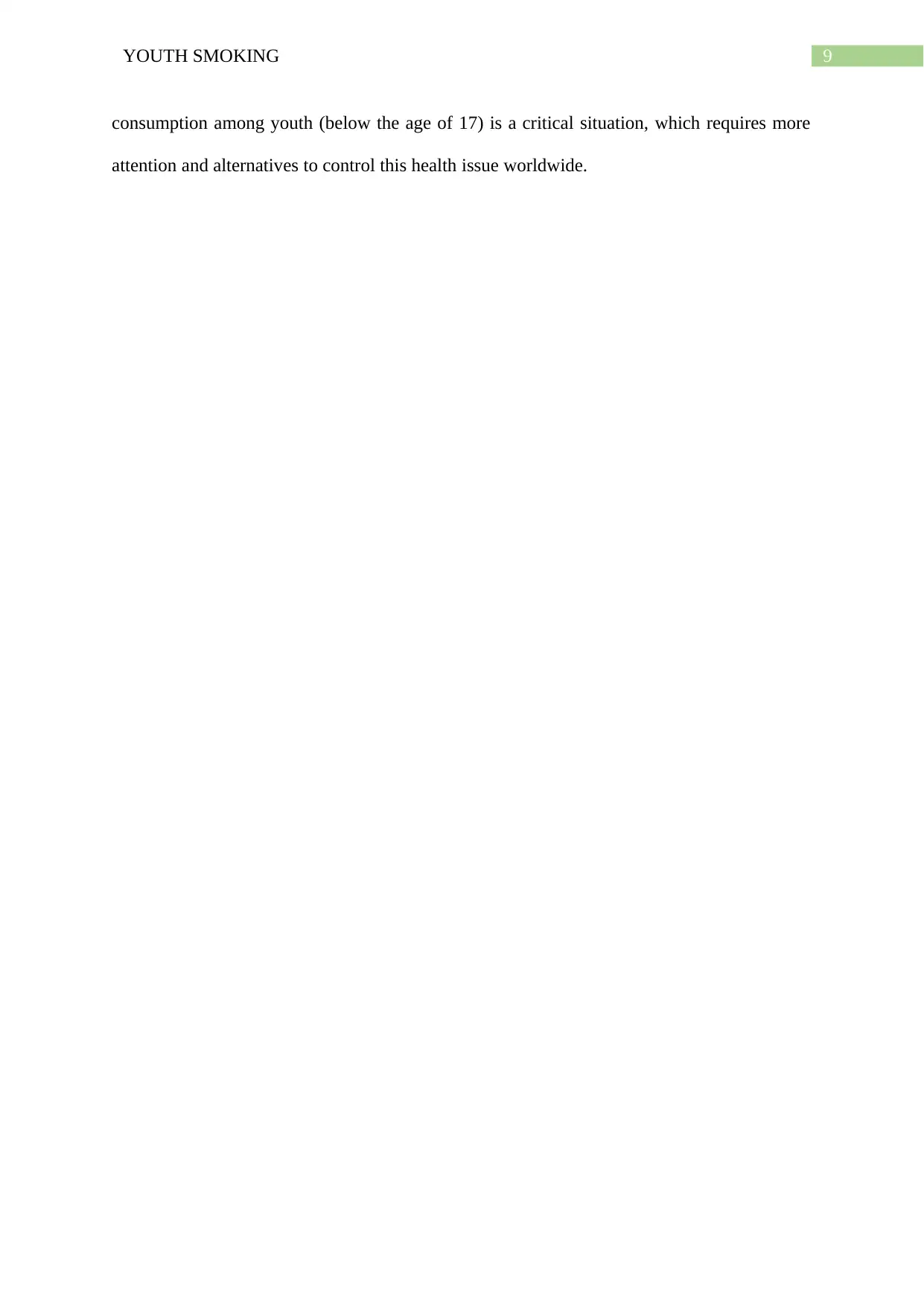
9YOUTH SMOKING
consumption among youth (below the age of 17) is a critical situation, which requires more
attention and alternatives to control this health issue worldwide.
consumption among youth (below the age of 17) is a critical situation, which requires more
attention and alternatives to control this health issue worldwide.
Secure Best Marks with AI Grader
Need help grading? Try our AI Grader for instant feedback on your assignments.
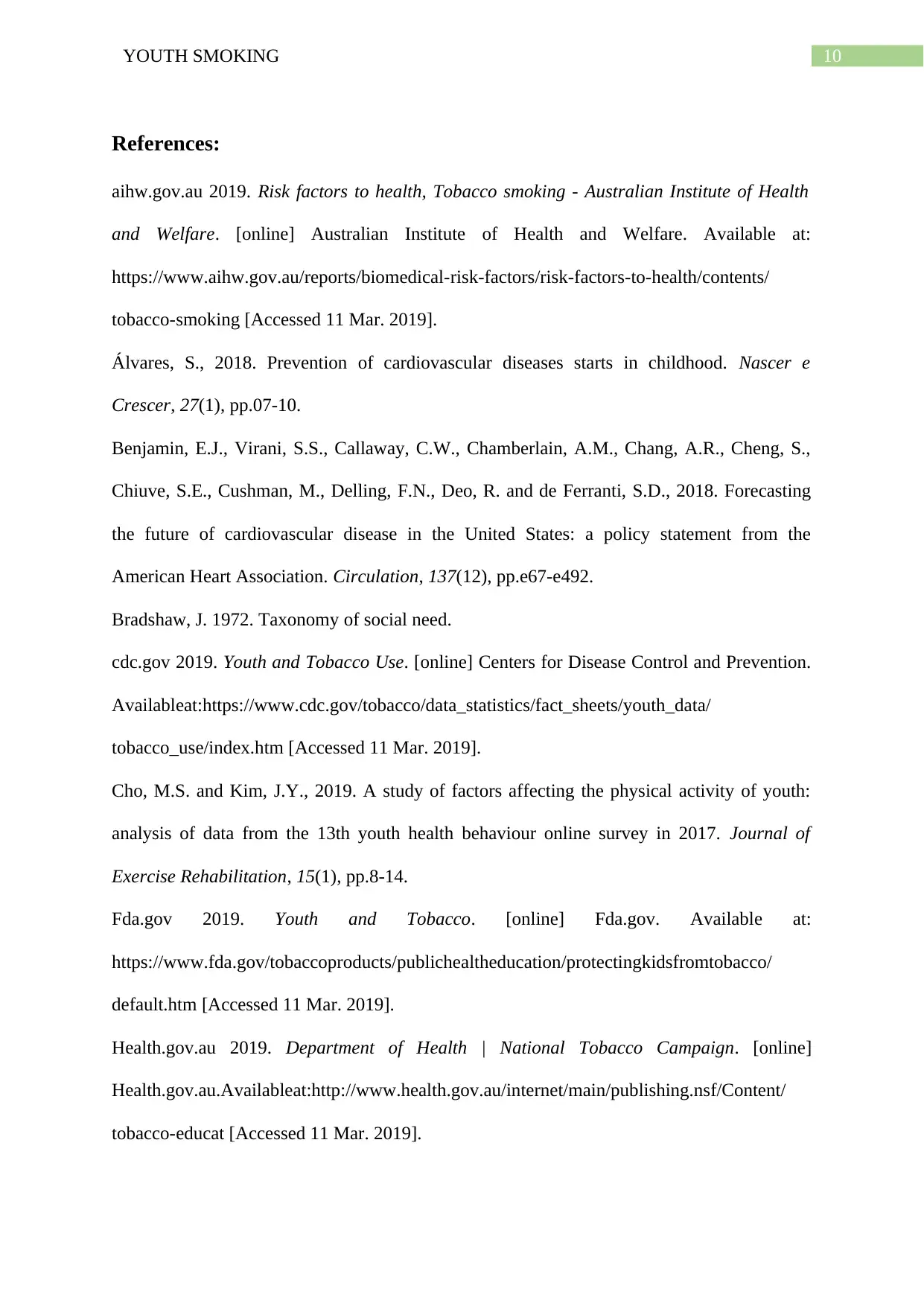
10YOUTH SMOKING
References:
aihw.gov.au 2019. Risk factors to health, Tobacco smoking - Australian Institute of Health
and Welfare. [online] Australian Institute of Health and Welfare. Available at:
https://www.aihw.gov.au/reports/biomedical-risk-factors/risk-factors-to-health/contents/
tobacco-smoking [Accessed 11 Mar. 2019].
Álvares, S., 2018. Prevention of cardiovascular diseases starts in childhood. Nascer e
Crescer, 27(1), pp.07-10.
Benjamin, E.J., Virani, S.S., Callaway, C.W., Chamberlain, A.M., Chang, A.R., Cheng, S.,
Chiuve, S.E., Cushman, M., Delling, F.N., Deo, R. and de Ferranti, S.D., 2018. Forecasting
the future of cardiovascular disease in the United States: a policy statement from the
American Heart Association. Circulation, 137(12), pp.e67-e492.
Bradshaw, J. 1972. Taxonomy of social need.
cdc.gov 2019. Youth and Tobacco Use. [online] Centers for Disease Control and Prevention.
Availableat:https://www.cdc.gov/tobacco/data_statistics/fact_sheets/youth_data/
tobacco_use/index.htm [Accessed 11 Mar. 2019].
Cho, M.S. and Kim, J.Y., 2019. A study of factors affecting the physical activity of youth:
analysis of data from the 13th youth health behaviour online survey in 2017. Journal of
Exercise Rehabilitation, 15(1), pp.8-14.
Fda.gov 2019. Youth and Tobacco. [online] Fda.gov. Available at:
https://www.fda.gov/tobaccoproducts/publichealtheducation/protectingkidsfromtobacco/
default.htm [Accessed 11 Mar. 2019].
Health.gov.au 2019. Department of Health | National Tobacco Campaign. [online]
Health.gov.au.Availableat:http://www.health.gov.au/internet/main/publishing.nsf/Content/
tobacco-educat [Accessed 11 Mar. 2019].
References:
aihw.gov.au 2019. Risk factors to health, Tobacco smoking - Australian Institute of Health
and Welfare. [online] Australian Institute of Health and Welfare. Available at:
https://www.aihw.gov.au/reports/biomedical-risk-factors/risk-factors-to-health/contents/
tobacco-smoking [Accessed 11 Mar. 2019].
Álvares, S., 2018. Prevention of cardiovascular diseases starts in childhood. Nascer e
Crescer, 27(1), pp.07-10.
Benjamin, E.J., Virani, S.S., Callaway, C.W., Chamberlain, A.M., Chang, A.R., Cheng, S.,
Chiuve, S.E., Cushman, M., Delling, F.N., Deo, R. and de Ferranti, S.D., 2018. Forecasting
the future of cardiovascular disease in the United States: a policy statement from the
American Heart Association. Circulation, 137(12), pp.e67-e492.
Bradshaw, J. 1972. Taxonomy of social need.
cdc.gov 2019. Youth and Tobacco Use. [online] Centers for Disease Control and Prevention.
Availableat:https://www.cdc.gov/tobacco/data_statistics/fact_sheets/youth_data/
tobacco_use/index.htm [Accessed 11 Mar. 2019].
Cho, M.S. and Kim, J.Y., 2019. A study of factors affecting the physical activity of youth:
analysis of data from the 13th youth health behaviour online survey in 2017. Journal of
Exercise Rehabilitation, 15(1), pp.8-14.
Fda.gov 2019. Youth and Tobacco. [online] Fda.gov. Available at:
https://www.fda.gov/tobaccoproducts/publichealtheducation/protectingkidsfromtobacco/
default.htm [Accessed 11 Mar. 2019].
Health.gov.au 2019. Department of Health | National Tobacco Campaign. [online]
Health.gov.au.Availableat:http://www.health.gov.au/internet/main/publishing.nsf/Content/
tobacco-educat [Accessed 11 Mar. 2019].
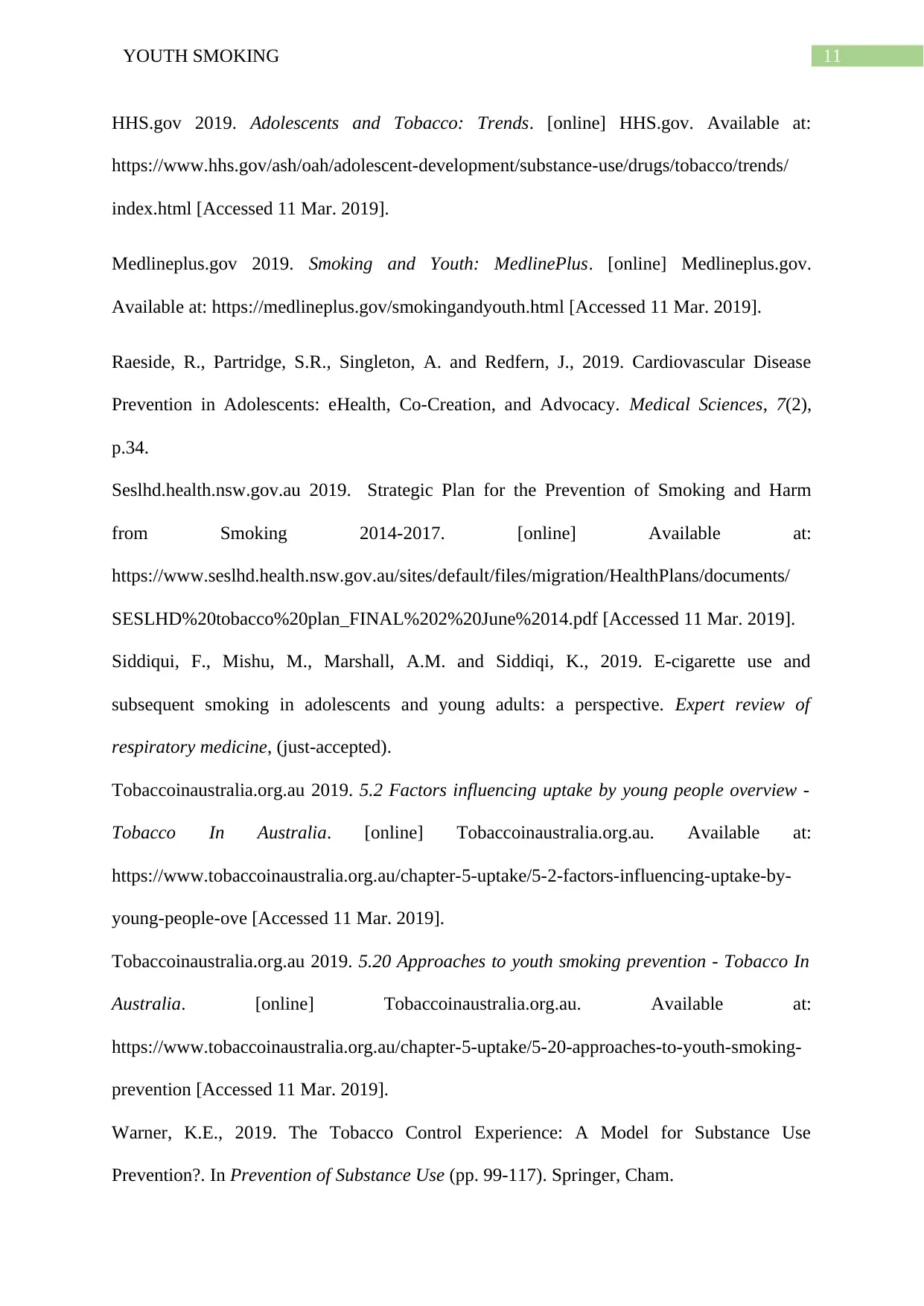
11YOUTH SMOKING
HHS.gov 2019. Adolescents and Tobacco: Trends. [online] HHS.gov. Available at:
https://www.hhs.gov/ash/oah/adolescent-development/substance-use/drugs/tobacco/trends/
index.html [Accessed 11 Mar. 2019].
Medlineplus.gov 2019. Smoking and Youth: MedlinePlus. [online] Medlineplus.gov.
Available at: https://medlineplus.gov/smokingandyouth.html [Accessed 11 Mar. 2019].
Raeside, R., Partridge, S.R., Singleton, A. and Redfern, J., 2019. Cardiovascular Disease
Prevention in Adolescents: eHealth, Co-Creation, and Advocacy. Medical Sciences, 7(2),
p.34.
Seslhd.health.nsw.gov.au 2019. Strategic Plan for the Prevention of Smoking and Harm
from Smoking 2014-2017. [online] Available at:
https://www.seslhd.health.nsw.gov.au/sites/default/files/migration/HealthPlans/documents/
SESLHD%20tobacco%20plan_FINAL%202%20June%2014.pdf [Accessed 11 Mar. 2019].
Siddiqui, F., Mishu, M., Marshall, A.M. and Siddiqi, K., 2019. E-cigarette use and
subsequent smoking in adolescents and young adults: a perspective. Expert review of
respiratory medicine, (just-accepted).
Tobaccoinaustralia.org.au 2019. 5.2 Factors influencing uptake by young people overview -
Tobacco In Australia. [online] Tobaccoinaustralia.org.au. Available at:
https://www.tobaccoinaustralia.org.au/chapter-5-uptake/5-2-factors-influencing-uptake-by-
young-people-ove [Accessed 11 Mar. 2019].
Tobaccoinaustralia.org.au 2019. 5.20 Approaches to youth smoking prevention - Tobacco In
Australia. [online] Tobaccoinaustralia.org.au. Available at:
https://www.tobaccoinaustralia.org.au/chapter-5-uptake/5-20-approaches-to-youth-smoking-
prevention [Accessed 11 Mar. 2019].
Warner, K.E., 2019. The Tobacco Control Experience: A Model for Substance Use
Prevention?. In Prevention of Substance Use (pp. 99-117). Springer, Cham.
HHS.gov 2019. Adolescents and Tobacco: Trends. [online] HHS.gov. Available at:
https://www.hhs.gov/ash/oah/adolescent-development/substance-use/drugs/tobacco/trends/
index.html [Accessed 11 Mar. 2019].
Medlineplus.gov 2019. Smoking and Youth: MedlinePlus. [online] Medlineplus.gov.
Available at: https://medlineplus.gov/smokingandyouth.html [Accessed 11 Mar. 2019].
Raeside, R., Partridge, S.R., Singleton, A. and Redfern, J., 2019. Cardiovascular Disease
Prevention in Adolescents: eHealth, Co-Creation, and Advocacy. Medical Sciences, 7(2),
p.34.
Seslhd.health.nsw.gov.au 2019. Strategic Plan for the Prevention of Smoking and Harm
from Smoking 2014-2017. [online] Available at:
https://www.seslhd.health.nsw.gov.au/sites/default/files/migration/HealthPlans/documents/
SESLHD%20tobacco%20plan_FINAL%202%20June%2014.pdf [Accessed 11 Mar. 2019].
Siddiqui, F., Mishu, M., Marshall, A.M. and Siddiqi, K., 2019. E-cigarette use and
subsequent smoking in adolescents and young adults: a perspective. Expert review of
respiratory medicine, (just-accepted).
Tobaccoinaustralia.org.au 2019. 5.2 Factors influencing uptake by young people overview -
Tobacco In Australia. [online] Tobaccoinaustralia.org.au. Available at:
https://www.tobaccoinaustralia.org.au/chapter-5-uptake/5-2-factors-influencing-uptake-by-
young-people-ove [Accessed 11 Mar. 2019].
Tobaccoinaustralia.org.au 2019. 5.20 Approaches to youth smoking prevention - Tobacco In
Australia. [online] Tobaccoinaustralia.org.au. Available at:
https://www.tobaccoinaustralia.org.au/chapter-5-uptake/5-20-approaches-to-youth-smoking-
prevention [Accessed 11 Mar. 2019].
Warner, K.E., 2019. The Tobacco Control Experience: A Model for Substance Use
Prevention?. In Prevention of Substance Use (pp. 99-117). Springer, Cham.
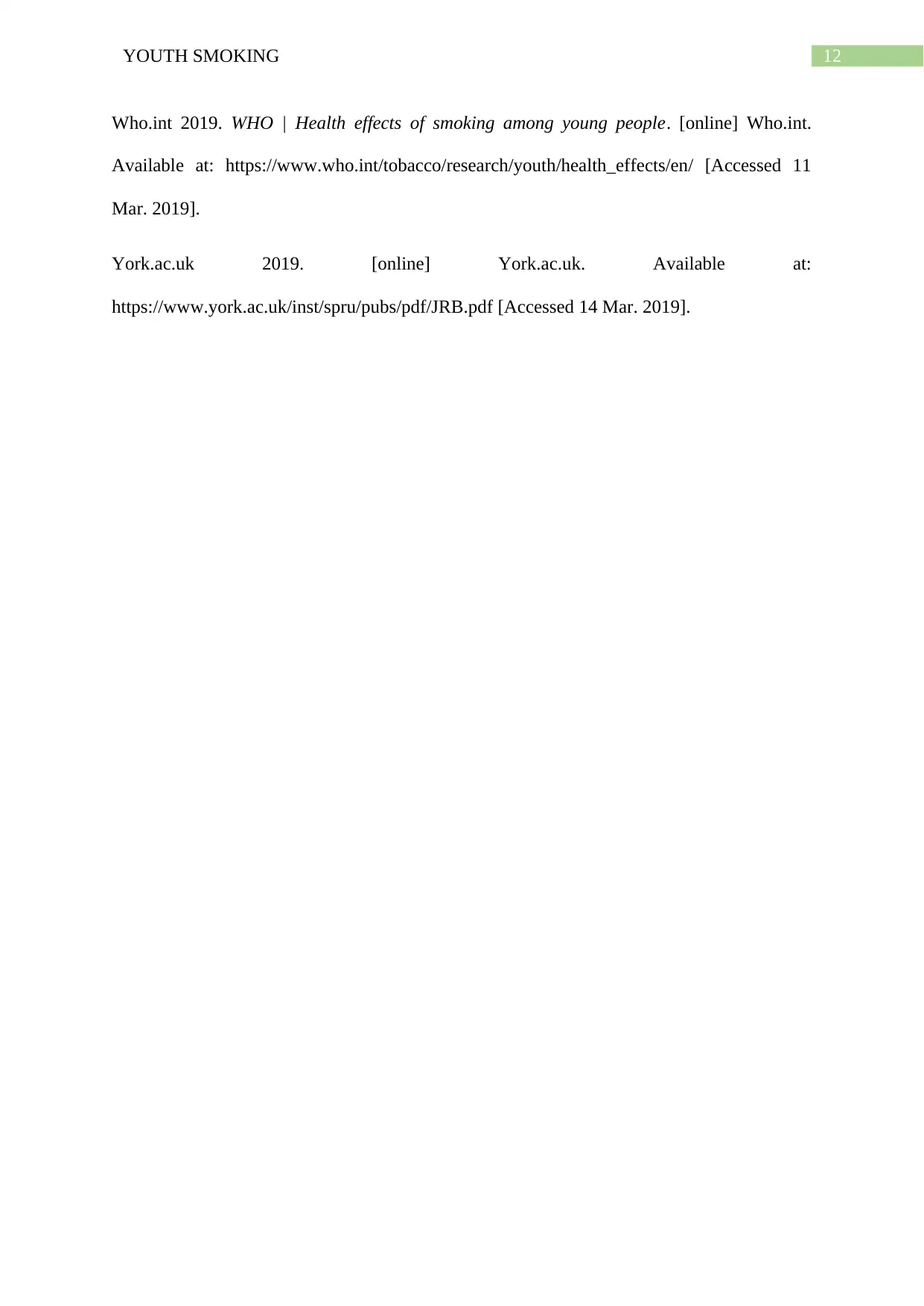
12YOUTH SMOKING
Who.int 2019. WHO | Health effects of smoking among young people. [online] Who.int.
Available at: https://www.who.int/tobacco/research/youth/health_effects/en/ [Accessed 11
Mar. 2019].
York.ac.uk 2019. [online] York.ac.uk. Available at:
https://www.york.ac.uk/inst/spru/pubs/pdf/JRB.pdf [Accessed 14 Mar. 2019].
Who.int 2019. WHO | Health effects of smoking among young people. [online] Who.int.
Available at: https://www.who.int/tobacco/research/youth/health_effects/en/ [Accessed 11
Mar. 2019].
York.ac.uk 2019. [online] York.ac.uk. Available at:
https://www.york.ac.uk/inst/spru/pubs/pdf/JRB.pdf [Accessed 14 Mar. 2019].
1 out of 13
Related Documents
Your All-in-One AI-Powered Toolkit for Academic Success.
+13062052269
info@desklib.com
Available 24*7 on WhatsApp / Email
![[object Object]](/_next/static/media/star-bottom.7253800d.svg)
Unlock your academic potential
© 2024 | Zucol Services PVT LTD | All rights reserved.





